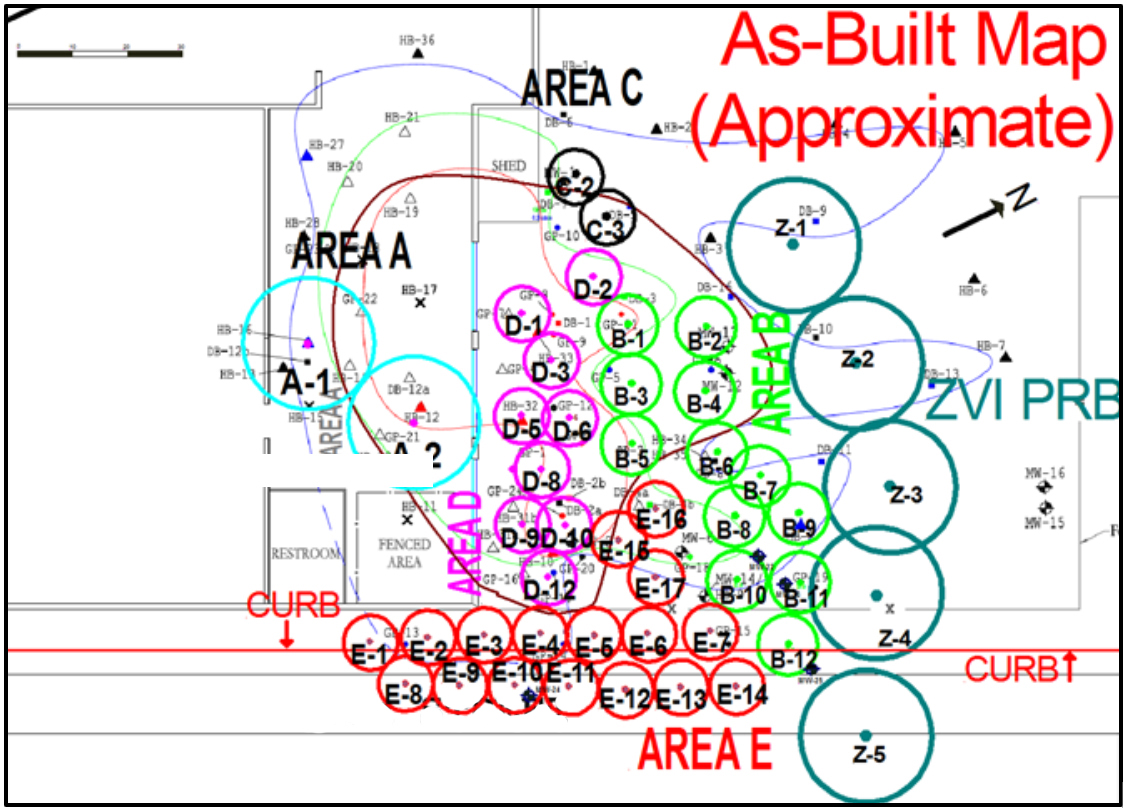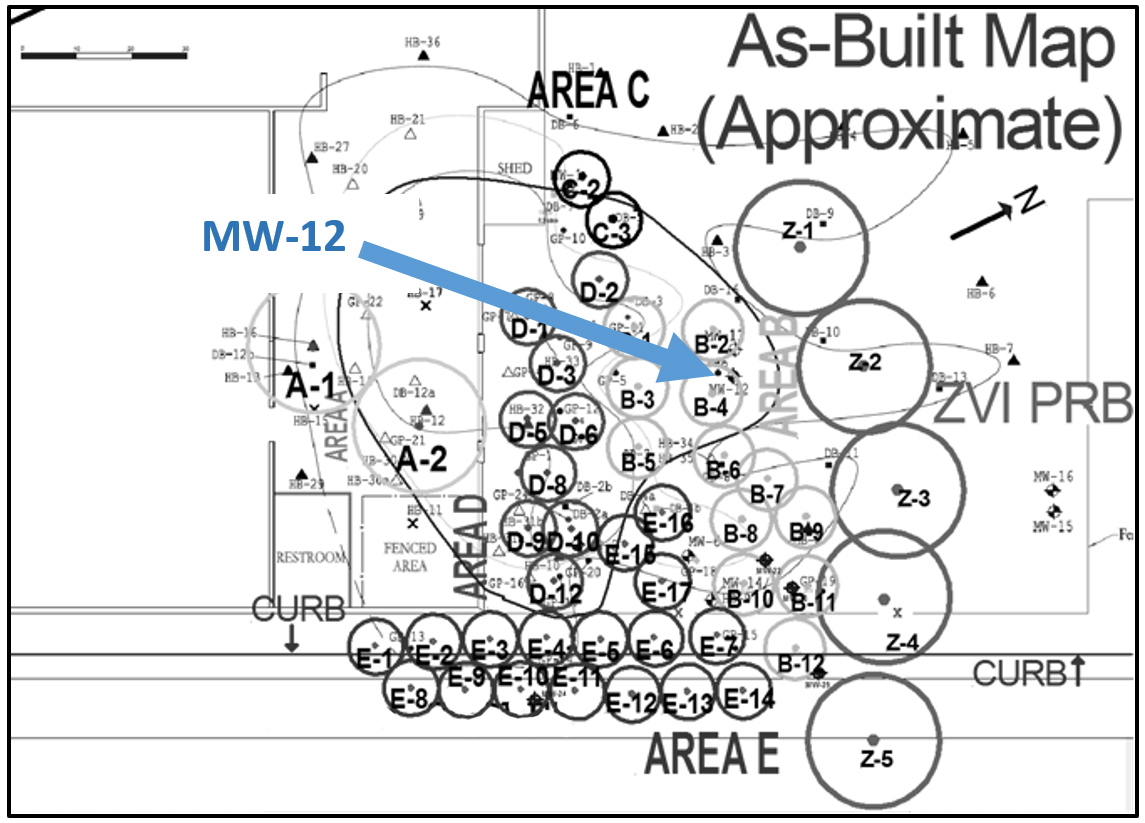Former Manufacturing Facility – East Orange, NJ
Site: Former Manufacturing Facility – East Orange, NJ
Constituents of Interest: Trichloroethylene, cis-1,2-Dichloroethene and Vinyl Chloride
Lead Contractor: Innovative Environmental Technologies, Inc. (IET)
Project Summary
Soil and groundwater at a former manufacturing facility in East Orange, NJ were impacted by trichloroethylene (TCE), cis-1,2, dichloroethene (cis-1,2-DCE) and vinyl chloride (VC) due to historical releases. The geology of the impacted matrix was primarily red-brown clayey silts with some occasional layers of fine sands. TCE concentrations in groundwater were as high as 99.1 mg/L. In November 2015, Innovative Environmental Technologies, Inc. (IET) implemented an in situ chemical reduction (ISCR) remediation program to enhance both abiotic and biological reductive processes (U.S. Patent #7,531,709). The primary goal of the remediation program was to limit plume migration to downgradient areas. The injection program included the application of emulsified zero valent iron (EZVI) to destroy source mass and minimize contaminant flux, ZVI, Provect-IR®, and additional site-specific reagents including kelp and Vitamin B12, to enhance abiotic and biotic reductive dechlorination processes. During November 2015, a total of 43 direct push injection points were utilized to distribute the approximately 6,435 gallons of remedial solutions within the targeted treatment areas (Figure 1).
During the baseline sampling event, 10 monitoring wells were sampled within and adjacent to the targeted treatment area. Eight of those wells (MW-1, MW-2, MW-12, MW-13, MW-14, MW-21 MW-22, and MW-23) are located within treatment areas targeted during the remedial injection event, while monitoring wells MW-15 and MW-16 are located to the northeast and hydrologically downgradient of the targeted treatment areas. Several post-treatment samples have been collected and analyzed for the targeted volatile organics and relevant geochemical conditions since the baseline sampling event to evaluate treatment program progress. Field parameters were also evaluated during groundwater sample collection. Overall, all monitoring wells have recorded considerable decreases in TCE concentrations. Specifically, TCE concentrations have decreased to below laboratory detection limits in monitoring wells MW-1, MW-12, MW-13, MW-14, MW-21 and MW-16, while in monitoring locations MW-2, MW-12, MW-23 and MW-15 it has decreased by 96%, 93%, 99% and 58%, respectively.
Due to the amount of available data, two representative wells were selected for site summary discussion; however, the comprehensive project analysis with individual monitoring well data sets can be provided.
MW-12 Location, Field Parameters and Geochemical Data: Monitoring well MW-12 is located slightly north of injection point B-4 (Figure 2) and is screened from 16.6 to 26.6 ft bgs. The field parameters and the geochemical data for monitoring well MW-12 are presented in Table 1 below.
The post-treatment groundwater pH values are neutral at 6.49 units, which is within the optimal range for dehalogenic bacteria to operate efficiently. The ORP has maintained strongly reducing conditions that were established immediately after the completion of the injection. The dissolved sulfate and total iron concentrations remain decreased indicating that sulfate and iron reduction processes are ongoing. The concentrations of dissolved gases continue to increase, which suggests that methanogenic and dehalogenic activities are occurring, and that methanogenesis is controlled. Based on data, the biogeochemistry appears to have been very favorably impacted by the remedial injection and the subsurface conditions remain conducive for reductive dechlorination processes to proceed.
MW-12 CVOC Data: During July 2017, the concentration of TCE decreased below laboratory detection limits (e.g. <5.3 μg/l). As expected, concentrations of the daughter compounds displayed increases in their respective concentrations during the first four post-injection sampling events; however, during the July 2017 sampling period, and as the reductive dechlorination reaction chain progresses, they have shown considerable decreases.
Specifically, the concentration of cis-1,2-DCE is currently at a new historic low and has decreased by 92% since the baseline sampling event. The concentration of vinyl chloride remains slightly above its baseline sampling measurements; however, recent sampling results indicate 86% reduction compared to its December 2016 sampling value.
MW-21 Location, Field Parameters and Geochemical Data: Monitoring well MW-21 is located near injection point E-5 (Figure 3) and it is screened between 14.5 to 24.5 ft bgs. The field parameters and the geochemical data for monitoring well MW-21 are presented in Table 3 below.
The post-treatment groundwater pH values are near neutral at 6.30 pH units. The ORP measurements have maintained reducing values at -78 mV, while conductivity measurements have exhibited increasing values post injection. The trends exhibited by these parameters suggest that remedial injectate continues to influence this area of the site and create biogeochemical conditions favorable for reductive dechlorination processes to proliferate.
Since the November 2015 injection, total iron concentrations have been highly elevated and most recently remain well above baseline levels (e.g. > 9 times above baseline). The decreased concentration of sulfate indicates the formation of pyrite and elevated concentrations of the dissolved gases methane, ethane and ethene, suggests that the fermentable material is still present in the area around MW-21. Furthermore, methanogenesis is being controlled and anaerobic reductive dechlorination processes are currently ongoing.
MW-21 CVOC Data: Groundwater TCE concentrations continue to exhibit decreasing trends and during the July 2017 sampling period it was measured at below laboratory detection limits. Daughter product formation resulted in an ephemeral spike in groundwater concentrations of cis-1,2 DCE and vinyl chloride, but since August 2016 the concentration of cis-1,2-DCE has decreased by 28%, while the concentration of vinyl chloride has decreased by 58% since December 2016. Based on the geochemistry that has been established near MW-21, it is anticipated that concentrations of all chlorinated compounds will continue to decrease.
Based on the groundwater monitoring data, the combination approach utilizing applications of EZVI, ZVI, and Provect-IR™ is very effectively decreasing concentrations of all chlorinated compounds. The injected material was successful in establishing and maintaining pH values within a circumneutral range, while simultaneously decreasing both the dissolved oxygen concentrations and ORP. The elevated conductivity measurements provide additional indications of subsurface injectate distribution and influence.
Overall, all monitoring wells have recorded considerable decreases in TCE concentrations. Specifically, TCE concentrations have decreased to below laboratory detection limits in monitoring wells MW-1, MW-12, MW-13, MW-14, MW-21 and MW-16, while in monitoring locations MW-2, MW-12, MW-23 and MW-15 it has decreased by 96%, 93%, 99% and 58%, respectively.
Due to the ongoing anaerobic reductive dechlorination reaction chain, an increase in the concentrations of the daughter products cis-1,2-DCE and vinyl chloride was initially observed in almost every well; however, those temporary increases have subsided and the concentrations of the daughter products in most of the wells have decreased below their respective baseline sampling values.
Overall the geochemistry of the subsurface has been favorably impacted by the injection event and the environment is currently supporting anaerobic reductive dechlorination reactions. Therefore, it is anticipated that the concentrations of the remaining contaminants will continue to decrease during the upcoming sampling events.








